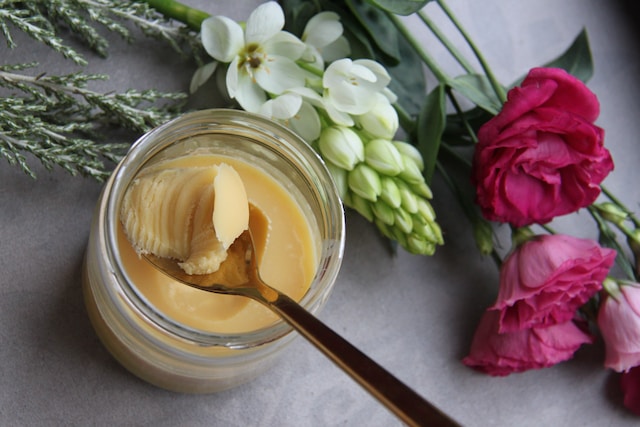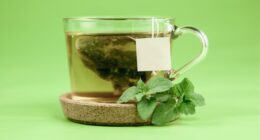Yellow shea butter is unrefined, raw, and retains its natural color, while white shea butter is refined, bleached, and has a lighter appearance.
What is shea butter?
Shea butter, derived from the nuts of the shea tree (Vitellaria paradoxa), is a natural fat that has been used for centuries in skincare and haircare regimens. This luxurious butter is native to Africa, where it holds deep cultural significance and has been cherished for its nourishing properties.
One of shea butter’s standout characteristics is its rich concentration of fatty acids, including oleic acid, stearic acid, linoleic acid, and palmitic acid. These fatty acids work together to provide intense hydration and moisture retention when applied topically.
What sets shea butter apart from other moisturizers is its ability to deeply penetrate the skin without leaving behind a greasy residue. It forms a protective barrier on the skin’s surface, sealing in moisture while shielding against environmental stressors.
Yellow shea butter

Yellow shea butter, also known as raw or unrefined shea butter, is a natural fat extracted from the nuts of the shea tree (Vitellaria paradoxa). It has a rich, yellow or beige color and a distinct nutty aroma. Yellow shea butter is produced through a traditional process that involves harvesting the shea nuts, drying and roasting them, and then grinding and kneading the nuts to extract the butter.
This type of shea butter is minimally processed and retains its natural nutrients, including vitamins A, E, and F, as well as essential fatty acids. It is highly valued for its moisturizing, nourishing, and healing properties, making it a popular ingredient in skincare, haircare, and cosmetic products. Yellow shea butter is known for its thicker consistency and can sometimes have a slightly grainy texture due to its unrefined nature.
White shea butter

White shea butter is a processed form of shea butter that has undergone refining and bleaching. It starts with the same raw shea butter, but it is further processed to remove impurities and achieve a lighter, off-white or white color. The refining process typically involves filtering the shea butter to remove any debris or sediment, followed by bleaching to lighten the natural color.
This type of shea butter undergoes additional steps to remove the nutty aroma, resulting in a milder or neutral scent. While white shea butter may have a smoother and creamier texture compared to its yellow counterpart, some of its natural nutrients and potential benefits may be reduced during the refining process. It is often preferred for cosmetic applications where a lighter color or milder scent is desired.
Yellow shea butter Vs. White shea butter – Key differences
| Yellow Shea Butter | White Shea Butter | |
|---|---|---|
| Color | Natural yellow or beige | White or off-white |
| Processing | Unrefined and raw | Refined and bleached |
| Scent | Strong nutty aroma | Mild or neutral scent |
| Texture | Slightly grainy or uneven | Smooth and creamy |
| Nutritional Content | Rich in natural vitamins and minerals | Some nutrients may be lost during refining |
| Moisturizing Properties | Deeply moisturizing and nourishing | Still moisturizing but may be less potent |
| Shelf Life | Shorter shelf life due to natural oils and fats | Longer shelf life due to refining process |
| Organic Certification | Often available as organic | May or may not be organic |
The benefits of shea butter
- Moisturizing: Shea butter is deeply hydrating and helps to nourish and moisturize the skin, keeping it soft, supple, and smooth.
- Anti-inflammatory: It contains anti-inflammatory properties that can help soothe and calm irritated or inflamed skin conditions such as eczema, psoriasis, and dermatitis.
- Anti-aging: Shea butter is rich in antioxidants, which can help combat free radicals and protect the skin from premature aging, reducing the appearance of wrinkles and fine lines.
- Healing properties: It contains natural healing agents, including vitamins A and E, which aid in the healing of wounds, scars, burns, and stretch marks.
- UV protection: Shea butter has a natural SPF of around 6, offering some degree of protection against the sun’s harmful UV rays.
- Hair care: Shea butter can be used to moisturize and nourish the hair, promoting healthy and shiny locks. It can also help reduce scalp irritation and dandruff.
- Anti-inflammatory: The anti-inflammatory properties of shea butter can help alleviate scalp inflammation and conditions such as dandruff, itchiness, and dryness.
- Versatility: Shea butter can be used in various forms, including creams, lotions, balms, and oils, making it a versatile ingredient for skincare, haircare, and even as a natural lip balm.
Image Credits
Featured Image By – Freepik
Image 1 By – Megumi Nachev on Unsplash
Image 2 By – Photo by Ron Lach :








